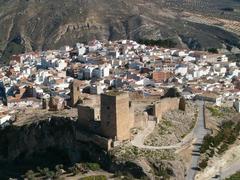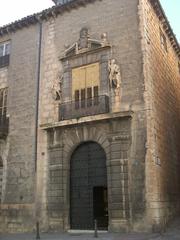Puerta del Ángel, Jaén, Spain: Visiting Hours, Tickets, and Historical Sites Guide
Date: 14/06/2025
Introduction
Nestled in the heart of Jaén, Andalusia, the Puerta del Ángel stands as the city’s last remaining gate from its historic fortifications. Built in 1646 and intimately connected to the adjacent Convento de las Bernardas, the monument is an enduring symbol of Jaén’s layered past. With its Renaissance stonework, semicircular arch, and the statue of Saint Michael the Archangel, the gate embodies the fusion of civic, religious, and defensive roles that shaped Jaén’s urban fabric. Today, it serves as both a tangible link to the city’s history and a vibrant portal to local life, festivals, and nearby attractions (castillosnet.org; virgendelacueva.es).
This detailed guide provides everything you need to know for your visit—historical background, architectural highlights, visiting hours, accessibility, guided tours, and tips for exploring Jaén’s nearby historical sites.
Table of Contents
- Introduction
- Historical Context and Urban Setting
- Architectural Features and Artistic Significance
- Urban and Social Role
- Visiting Hours and Tickets
- Accessibility and Visitor Tips
- Guided Tours and Special Events
- Nearby Attractions
- Visuals and Media Recommendations
- Preservation and Community Engagement
- Frequently Asked Questions (FAQ)
- Conclusion and Call to Action
- References
Historical Context and Urban Setting
Origins and Significance
The Puerta del Ángel—also known as the Puerta de San Miguel—was constructed in 1646 as part of Jaén’s second defensive wall, which expanded the city’s medieval perimeter to accommodate the growing San Ildefonso district (castillosnet.org; viajeroscallejeros.com). Jaén itself has a storied history, transitioning from an Iberian and Roman settlement to a Moorish stronghold (“Yayyan”), before being taken by Ferdinand III of Castile in 1246. The city’s defensive architecture—once encompassing numerous gates and towers—has mostly disappeared, making the Puerta del Ángel a rare survivor and a powerful symbol of this legacy (audiala.com).
Strategically positioned, the gate not only served military purposes but also marked the transition from the bustling city to the Alameda, a Renaissance garden that remains a key social space today.
Architectural Features and Artistic Significance
Structural Design
The gate features a semicircular (medio punto) arch constructed from finely cut stone voussoirs. Its proportions are balanced for both pedestrian and carriage passage, reflecting its role as a secondary city entrance. The structure is modest yet elegant, blending seamlessly into the cityscape and the adjacent convent (applicajaen.com).
Decorative Elements
- Central Niche (Hornacina): Houses a statue of Saint Michael the Archangel (San Miguel), who was regarded as Jaén’s protector against both physical and spiritual threats.
- Cornice and Frieze: A rectangular cartouche commemorates its construction.
- Triangular Pediment and Stone Finials: Classic Renaissance details, topped by a wrought iron cross.
- Stone Masonry: Exemplifies 17th-century craftsmanship with precise fitting and minimal but refined ornamentation (antoniogarciaprats.eu).
Urban and Social Role
The gate was more than a defensive structure. It provided access to the Alameda de Capuchinos (now Parque de la Alameda), Jaén’s main green space, and linked the city with surrounding districts. Beyond its practical use, its adjacency to the Convento de las Bernardas reflects the close ties between religious institutions and civic life in early modern Spain (virgendelacueva.es).
Today, the Puerta del Ángel is a vibrant node in Jaén’s urban life, serving as a backdrop for processions, festivals, and community events.
Visiting Hours and Tickets
- Puerta del Ángel: Freely accessible 24/7 as it is part of a public street; no entrance fees or tickets are required.
- Convento de las Bernardas: Access to the interior may be limited; guided tours or special exhibitions may require advance booking and a small fee.
Check the convent or official tourism sites for up-to-date information on interior visits and special events.
Accessibility and Visitor Tips
- The surrounding area is pedestrian-friendly but may have uneven cobblestone surfaces—comfortable footwear is recommended.
- Wheelchair Accessibility: The gate itself lacks dedicated ramps, but nearby parks and attractions are generally more accessible.
- Photography: Best light occurs in the early morning or late afternoon, highlighting the Renaissance stonework.
- Etiquette: Be mindful of the active convent next door and maintain a respectful volume.
Guided Tours and Special Events
- Local operators and the city tourism office offer guided walking tours of Jaén’s historic center, including the Puerta del Ángel (viajeroscallejeros.com).
- The gate often features in cultural events, especially during Cruces de Mayo and neighborhood festivals.
- For bookings and group arrangements, contact the convent or tourism office.
Nearby Attractions
- Convento de las Bernardas: Historic convent with beautiful architecture.
- Parque de la Alameda: Lush park adjacent to the gate, ideal for relaxation.
- Basilica of San Ildefonso: Notable baroque church, a short stroll away.
- Jaén Cathedral: Renaissance masterpiece within walking distance.
- Arab Baths (Baños Árabes): Among Spain’s best-preserved, located in the Palacio de Villardompardo.
- Plaza de la Constitución: Central square with shops and cafes.
Visuals and Media Recommendations
- High-quality images and virtual tours are available via local tourism websites.
- Suggested alt tags: “Puerta del Ángel Jaén Renaissance gate,” “Saint Michael statue at Puerta del Ángel.”
- View Map and Directions to Puerta del Ángel
Preservation and Community Engagement
Despite the loss of most of Jaén’s city walls, the Puerta del Ángel survives thanks to local heritage efforts and city support (applicajaen.com). The site is featured in educational programs, guided tours, and community events, fostering a sense of local pride and historical continuity.
Frequently Asked Questions (FAQ)
Q: What are the Puerta del Ángel visiting hours?
A: The gate is accessible 24/7 as a public monument.
Q: Do I need tickets to visit?
A: No tickets are required; access is free. Guided tours or convent visits may incur a fee.
Q: Is the site accessible for people with disabilities?
A: The immediate area is mostly flat but has some cobblestones. Parks and newer attractions nearby are more accessible.
Q: What are the nearest attractions?
A: Convento de las Bernardas, Alameda Park, Jaén Cathedral, Arab Baths, Plaza de la Constitución.
Q: Are guided tours available?
A: Yes, via local operators and the tourism office.
Conclusion and Call to Action
The Puerta del Ángel is a living testament to Jaén’s historical resilience and vibrant contemporary life. Its open access and central location make it a must-visit for anyone interested in Andalusian history, architecture, or local culture. For the best experience, combine your visit with nearby sites and consider a guided tour to gain deeper insight into Jaén’s rich past.
Download the Audiala app for interactive maps, guided tours, and the latest updates on Jaén’s attractions. Stay informed about events and visitor tips by following official tourism channels and our social media platforms.
References
- Puerta del Ángel Jaén: Visiting Hours, Tickets, and Historical Guide (castillosnet.org)
- Puerta del Ángel in Jaén and Convento de las Bernardas (virgendelacueva.es)
- Puerta del Ángel Architectural and Historical Insights (antoniogarciaprats.eu)
- Jaén Historical Sites and Visitor Information (viajeroscallejeros.com)
- Puerta del Ángel and Jaén City Guide (amusedbyandalucia.com)
- Spain Official Tourism Portal (spain.info)
- Preservation and Cultural Role of Puerta del Ángel (applicajaen.com)



